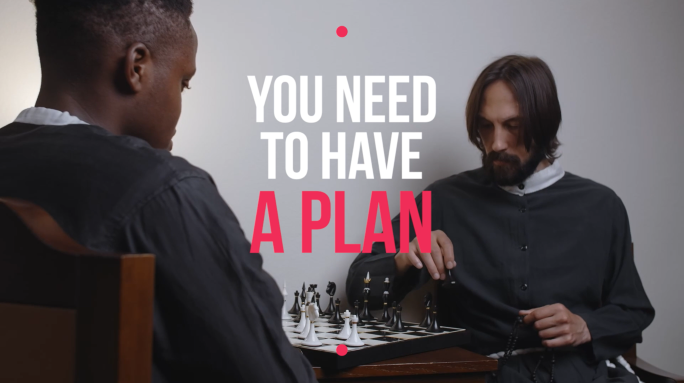Chess is a game that is universally known as an ideal platform for practicing critical thinking skills. The board game centers around 6 distinct pieces and a playing board of 64 squares of alternating colors, typically black and white. While competing, players will engage in a tension-filled tension and reaction to determine the next best move for the road to triumph. Even though this game has been played by medieval monarchs for over a thousand years, many beginners may require assistance to navigate the game. Read on for our concise step-by-step guide on how to teach yourself how to play chess.
How To Teach Yourself To Play Chess
1. Set up your chessboard
The game is equipped with a board consisting of a series of horizontal rows, which are numerically labeled 1-8 against vertical columns marked as A-H. Altogether, there are 64 squares on the boards and when placed in the proper coordination each side of the board will have a white square on the bottom right.

Following that, players should familiarize themselves with the arrangement of the chess pieces on the board. Each chess piece signifies a unique role and should be placed on the designated square as stated below:
• Pawns: Set all your Pawns on the second row.
• Rooks (the castles): Place these pieces on the farther left and right of the board.
• Knights (the horses): These pieces should be placed right next to the Rooks moving towards the center of the board.
• Bishop: Place the Bishops right next to the Knights.
• King: The King piece should be placed on the middle square that contrasts its color, for example, a white King on a black square.
• Queen: The Queen piece should be in the middle square that matches its color, quite the opposite of the King piece.
2. Learn how to move the chess pieces.
Like assigned roles to castle members, each distinct piece has special movements owing to their separate hierarchy. Many players are intimidated by the seemingly complex rules of the movement of the chess pieces, but with a little help as shown below, you will get familiarized with it in no time.
• Pawn: On the first move, Pawns are granted the ability to move 2 spaces forward. Otherwise, from then on, they can only move 1 space forward and capture another piece diagonally. When a Pawn successfully gets to the end of the opposite board, you get to switch it to another piece except for the King.
• Rook: The Rooks can move horizontally or vertically as many spaces are available.
• Knight: These pieces move in an ‘L’ shape either with two spaces vertically or horizontally and the other one space in an opposite direction in a 90° manner. It allows Knight pieces to jump over pieces of both colors in the space where it settles.
• Bishop: Bishops can only move diagonally on similar colored squares in an unlimited amount of spaces per direction.
• Queen: Queens have a wide range of movement including horizontal, vertical, and diagonal in any direction or number of spaces, and captures similarly.
• King: The King piece is the most valuable but only moves one space each turn in any direction and captures in this orientation too.

3. Understand the special moves or terms of chess.
You have heard the term “castling” so many times in chess. But, what is it, really? Under this segment, you will be further introduced to some chess terms you have heard before but may not understand.
Pawn promotion
If you manage to move a pawn to the opposite side of the board, you may then switch it to your desired choice of Queen, Rook, Bishop, or Knight piece. Simply remove the pawn piece from the board and convert it to the chess piece of your choice. Naturally, the Queen piece is a popular option for its high versatility.
En passant
“En passant”, or French for “in passing” applies only to pawn pieces. If a pawn, on its first move where it’s specifically granted 2 space movements, lands on the side of an opponent’s pawn, the latter has the option to capture the opponent pawn in a diagonal direction.
Castling
This move allows players to move their King and a Rook on a similar turn, where the King has moved 2 squares towards a Rook followed by placing the Rock next to the King on either side of the board. Castling is only allowed where both the Rook and King have no prior movement in the game with no pieces between them. Another situational circumstance that may apply to this rule is that it can’t be performed if the King is in check.
4. Decide how to win the game.
The game will end either through a checkmate, a draw, or the resignation of the opponent.
Checkmate
The primary objective of the game is to checkmate the opponent’s King when a King is in check and is unable to escape it. A King piece may escape a check by moving out of it, blocking the check, or capturing the threatening piece. The game is over after a checkmate is declared.
Draw
A draw can happen under several circumstances in the game. For instance, in a stalemate, a player’s King manages to run out of legitimate moves but is not in check. Other situations include insufficient pieces on board to achieve a checkmate or both players agreeing to stop playing.

5. Start playing and practicing
Now that you are familiar with the orientation and roles of the elements of the game, it is time to take these theories into practice. Remember, the first player is always the one with white pieces. While playing, bear in mind that the goal is to achieve a checkmate so protect your king at all cost. As you keep playing, you will eventually get better at the game.
The saying ‘practice makes perfect is especially true when it comes to chess. In time, you will learn that one of the attractive points of the game is its simplicity, which can be enjoyed by both grand-masters and players at all skill levels.
If you want to go beyond being just a beginner at this or any other skill, and work toward developing a real mastery, then you are going to need a deeper and more powerful strategy. What you need is a way to hack your brain so you can develop a winning mindset.
A winning mindset is a state of mind that allows you to enter a flow state at will. You do this by programming your subconscious mind.

Believe it or not, most of what you do throughout an average day is NOT freely chosen by your normal waking consciousness even though it may seem that way. The truth is that most of what you do on a day-to-day basis is done on autopilot. An example of this would be when you’re driving your car and as you do so you get bored and begin daydreaming. Before you know it, you find yourself several miles further down the road with absolutely NO memory of having driven those last several miles.
So, who exactly was driving while your waking consciousness was in la-la land, and how exactly did you manage to avoid an accident? Your subconscious mind was in control. You already spent years programming your subconscious with how to deal with a broad range of possible driving scenarios and thus it had no trouble taking the wheel while your waking consciousness took a little break. In other words, you were able to take effective actions without having to THINK about them.
The same way you programmed your subconscious to drive, you can also program it to automatically take successful actions toward mastering any other skill you decide that you want to learn. CLICK HERE to learn a proven, step-by-step formula to help you attain mastery at any skill you choose and achieve everything in life.
At Online Super Tutors, we offer tutoring services for both adults and kids in a variety of subjects: Whether you’re looking to improve your grades, prepare for a standardized test, or simply want to learn something new, super tutoring can help. So why wait? Get in touch with us today and start your journey towards academic success!
Please see our Google reviews below as an example of what our clients feel about us:






